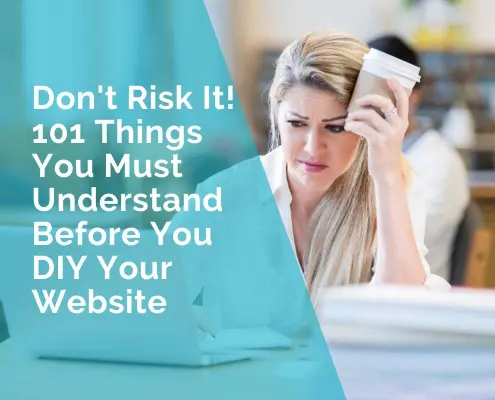How to Establish Credibility and Expertise on Your Website
Your website often makes the first and most impactful impression. Potential clients, partners, and investors judge your credibility within seconds, relying on your design, messaging, and the signals you send. A polished layout alone doesn’t earn trust. People want evidence that you know your field and stand behind your claims.
You can’t claim credibility and expertise outright. You need to demonstrate them through clear content, consistent presentation, and real insight. Every detail matters, from how you introduce your team to how you explain your services. A well-crafted website strengthens your professional reputation and builds confidence before a single conversation takes place.
Clarify Your Value Proposition on the Homepage
A confusing homepage is one of the fastest ways to lose a visitor. People decide within seconds whether a business looks credible, relevant, and trustworthy. An effective website offers a clear value proposition that helps visitors make that decision in your favour. It tells them what you do, who you help, and why they should care.
Use Specific Language That Describes What You Do
Avoid abstract phrases like “driving innovation” or “empowering success.” These don’t tell the reader what your business actually does. Instead, use clear, industry-relevant language that spells out your core offering. If you manage social media for restaurants, say exactly that. Specificity builds trust by showing that you understand your work and your audience.
Place the Most Important Message at the Top
Don’t expect visitors to scroll. Put your main message above the fold—ideally in the first headline and supporting sentence. Anything lower on the page should reinforce or expand on the core idea. If your key selling point isn’t visible without effort, it likely won’t be seen at all.
Support Your Message with Clear Subheadings and Layout
A value proposition doesn’t stand alone. Use subheadings to explain how you work, who you work with, or what results clients can expect. Keep paragraphs short. Use line breaks and simple structure to help readers scan. The way your content looks affects how credible it feels.
Avoid Claims You Can’t Prove
Generic statements like “top-rated agency” or “trusted by thousands” fall flat unless you support them later with data or proof. Overstating your position can raise doubts instead of building trust. Keep claims grounded in what you can actually show through results, testimonials, or credentials elsewhere on the site.
Craft a Transparent “About Us” Page That Builds Connection
Your “About Us” page often ranks among the most visited on your site. People go there to understand who’s behind the business, what you stand for, and why they should trust you. A generic company blurb won’t do the job. To build credibility, your “About” page should be personal, detailed, and structured with the reader in mind.
Introduce Real People, Not Roles
Skip corporate generalities like “our team is dedicated to excellence.” Instead, introduce actual team members with names, titles, and a short description of what they do. This shows transparency and gives your business a human face, which helps people feel more confident about working with you.
Use Authentic Photos to Reinforce Trust
Stock images weaken credibility. Use real headshots or group photos that reflect your team’s character and culture. If professional photography isn’t an option yet, consider tools like a free headshot generator with AI to create more presentable, consistent visuals while you prepare for a full photo shoot.
Include Individual Bios That Highlight Expertise
Give each key team member a short bio that covers relevant experience, areas of focus, and professional background. This is your chance to show real qualifications, not just enthusiasm. When readers see that your leadership or team has done meaningful work in the field, your site gains immediate authority.
Demonstrate Expertise Through Educational Content
People trust businesses that teach them something useful. Educational content lets you show your knowledge instead of just stating it. By offering insights your audience hasn’t seen before, you establish yourself as a source of practical value.
Publish In-Depth, Audience-Focused Articles
Surface-level blog posts won’t build trust. Choose topics your target clients care about, then answer their questions in depth. Focus on clarity, structure, and real takeaways. Use examples, frameworks, or case scenarios to show how your expertise applies to real-world situations.
Write How-To Guides That Solve Specific Problems
Broad advice like “improve productivity” has little impact. Create focused guides that solve precise challenges, such as “how to reduce churn in subscription businesses” or “how to onboard a virtual assistant.” The more specific the problem, the more your guide will stand out and serve its purpose.
Use Original Ideas, Not Just Summaries
Avoid rehashing popular content from elsewhere. Share your own perspective, methodology, or insight gained from experience. Unique approaches signal that you’re an active thinker in your field, not someone repeating what others have said.
Offer Downloadable Resources or Templates
Supplement written content with practical tools. A worksheet, calculator, checklist, or decision-making flowchart can reinforce your authority. These tools give your audience something to use immediately, and they demonstrate that you understand the actual work behind the advice.
Use High-Quality Visuals to Support Credibility
Visual design influences trust before a single word is read. A cluttered layout, inconsistent branding, or stock imagery can raise doubts about your professionalism. In contrast, clean visuals and cohesive design reinforce that you take your business seriously. Visuals don’t need to be flashy. Instead, they need to feel intentional.
Maintain a Clean and Cohesive Design
Your website should look considered and consistent. Use a clear colour palette, legible fonts, and structured layouts. Avoid overwhelming visitors with animations, pop-ups, or disorganised sections. When your site feels calm and organised, people associate those qualities with your business as well.
Avoid Generic or Overused Stock Photos
Images that feel staged or impersonal reduce credibility. Whenever possible, use original photos—your workspace, your process, your team, or your product in use. If you must use stock images, choose ones that feel natural and match your tone.
Use Visual Cues to Support Key Messages
Design should direct attention. Use icons, pull quotes, or highlighted figures to reinforce specific claims or guide the reader. These visual cues help visitors understand your message faster and remember it longer.
Optimise for Mobile and Accessibility
A website that looks polished on desktop but breaks on mobile loses credibility instantly. Visitors expect fast, seamless access across all devices, and anything less suggests carelessness. Accessibility matters just as much. If parts of your site are hard to read, click, or understand, it reflects poorly on your attention to detail and excludes potential clients.
- Use responsive design that adapts to all screen sizes without horizontal scrolling
- Avoid small text or dense blocks of copy—use readable font sizes and spacing
- Make buttons and links large enough for easy tapping on mobile devices.
- Maintain strong colour contrast for readability, especially on light backgrounds
- Add descriptive alt text for all images, especially those used to convey meaning
- Use descriptive link text instead of “click here” so screen readers can interpret context
- Test your site on various browsers and devices to catch layout or loading issues
- Ensure all interactive elements can be accessed via keyboard navigation
Add Social Proof That Reinforces Expertise
Social proof helps people feel confident in their decision to trust you. When visitors see that others have worked with you and had a positive experience, your credibility increases. But not all social proof is equal. It works best when it’s relevant, specific, and presented with context.
Include Testimonials That Mention Specific Results
Generic praise like “great service” doesn’t do much. Choose testimonials that highlight measurable outcomes or concrete improvements. A quote that references time saved, revenue increased, or a specific challenge overcome is far more persuasive.
Showcase Recognisable Clients or Partners
Logos can signal credibility, but only when used sparingly and with permission. If you’ve worked with well-known companies or institutions, place their logos in a section clearly marked as “Clients” or “Trusted By.” Always include context when possible—for example, linking to a project summary or case study.
Highlight Industry Credentials and Certifications
Official recognition can validate your expertise. If you or your team hold relevant certifications, awards, or memberships, include them in a visible area—ideally with brief explanations of what they mean and why they matter to your audience.
Link to External Reviews and Ratings
If you collect reviews on third-party platforms like Google, Trustpilot, or industry directories, link to them from your site. These add transparency and give readers a chance to explore unfiltered feedback. Choose platforms your audience is likely to recognise and trust.
Make It Easy to Contact and Engage With You
A credible business is easy to reach. If your website hides contact details or forces visitors through unclear processes, it creates friction and raises doubts. Being accessible, responsive, and transparent shows that you take communication seriously.
Display Contact Information Clearly
Avoid burying contact details in footers or obscure pages. Include a visible “Contact” link in your main navigation. Display phone numbers, email addresses, and physical locations (if relevant) in easy-to-find places. The more accessible you seem, the more trustworthy you appear.
Offer Multiple Contact Options
Different users prefer different channels. Some want to call, others prefer email or live chat. Provide at least two methods of contact to reduce hesitation. If you serve a professional audience, offering direct booking links or short enquiry forms can improve conversion.
Respond Promptly and Professionally
Credibility doesn’t end once someone clicks “submit.” Follow through quickly and clearly. Set expectations about response time and stick to them. If users wait too long or get vague replies, your earlier credibility signals lose their value.
Wrapping Up
Trust doesn’t happen by chance. It’s earned through choices. What you reveal, how you present it, and the signals you send at every step matter. Your website can either confirm your authority or quietly undermine it. Every detail speaks.
When someone visits your site, they’re deciding if you’re worth their time, money, or partnership. You don’t get a second chance to guide that decision. Build each page with the assumption that the right people are already watching. If your expertise is real, show it. If your work creates results, prove it. If you stand behind what you do, let it be visible.
***************
Tania Nichols










